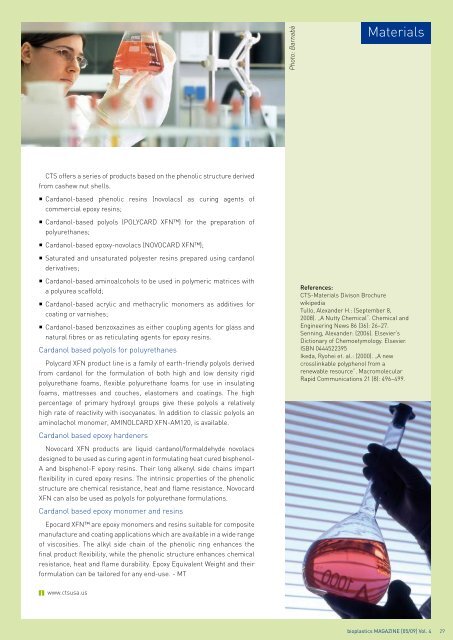bioplasticsMAGAZINE_0905
bioplasticsMAGAZINE_0905
bioplasticsMAGAZINE_0905
Create successful ePaper yourself
Turn your PDF publications into a flip-book with our unique Google optimized e-Paper software.
Photo: Barnabà<br />
Materials<br />
CTS offers a series of products based on the phenolic structure derived<br />
from cashew nut shells.<br />
• Cardanol-based phenolic resins (novolacs) as curing agents of<br />
commercial epoxy resins;<br />
• Cardanol-based polyols (POLYCARD XFN) for the preparation of<br />
polyurethanes;<br />
• Cardanol-based epoxy-novolacs (NOVOCARD XFN);<br />
• Saturated and unsaturated polyester resins prepared using cardanol<br />
derivatives;<br />
• Cardanol-based aminoalcohols to be used in polymeric matrices with<br />
a polyurea scaffold;<br />
• Cardanol-based acrylic and methacrylic monomers as additives for<br />
coating or varnishes;<br />
• Cardanol-based benzoxazines as either coupling agents for glass and<br />
natural fibres or as reticulating agents for epoxy resins.<br />
Cardanol based polyols for poluyrethanes<br />
Polycard XFN product line is a family of earth-friendly polyols derived<br />
from cardanol for the formulation of both high and low density rigid<br />
polyurethane foams, flexible polyurethane foams for use in insulating<br />
foams, mattresses and couches, elastomers and coatings. The high<br />
percentage of primary hydroxyl groups give these polyols a relatively<br />
high rate of reactivity with isocyanates. In addition to classic polyols an<br />
aminolachol monomer, AMINOLCARD XFN-AM120, is available.<br />
Cardanol based epoxy hardeners<br />
Novocard XFN products are liquid cardanol/formaldehyde novolacs<br />
designed to be used as curing agent in formulating heat cured bisphenol-<br />
A and bisphenol-F epoxy resins. Their long alkenyl side chains impart<br />
flexibility in cured epoxy resins. The intrinsic properties of the phenolic<br />
structure are chemical resistance, heat and flame resistance. Novocard<br />
XFN can also be used as polyols for polyurethane formulations.<br />
Cardanol based epoxy monomer and resins<br />
Epocard XFN are epoxy monomers and resins suitable for composite<br />
manufacture and coating applications which are available in a wide range<br />
of viscosities. The alkyl side chain of the phenolic ring enhances the<br />
final product flexibility, while the phenolic structure enhances chemical<br />
resistance, heat and flame durability. Epoxy Equivalent Weight and their<br />
formulation can be tailored for any end-use. - MT<br />
References:<br />
CTS-Materials Divison Brochure<br />
wikipedia<br />
Tullo, Alexander H.: (September 8,<br />
2008). „A Nutty Chemical“. Chemical and<br />
Engineering News 86 (36): 26–27.<br />
Senning, Alexander: (2006). Elsevier‘s<br />
Dictionary of Chemoetymology. Elsevier.<br />
ISBN 0444522395<br />
Ikeda, Ryohei et. al.: (2000). „A new<br />
crosslinkable polyphenol from a<br />
renewable resource“. Macromolecular<br />
Rapid Communications 21 (8): 496–499.<br />
www.ctsusa.us<br />
bioplastics MAGAZINE [05/09] Vol. 4 29


















